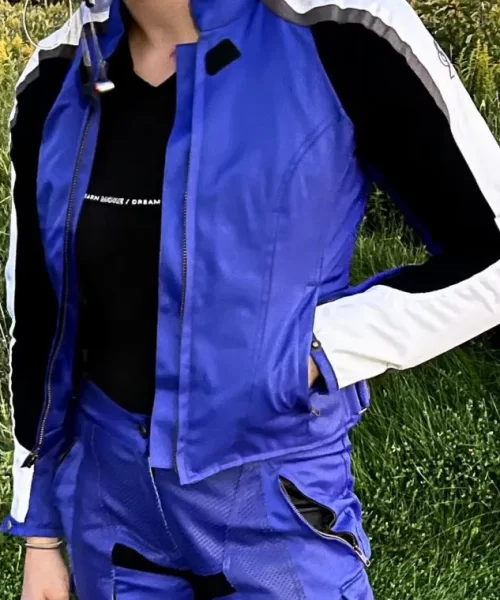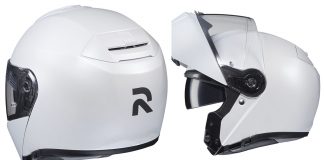A lot is going on with the Arai Signet-X in terms of features and functions, so its weight of 3.4 pounds (Large helmet) is impressive. That light weight makes for day-long comfort, wearability, and less rider fatigue.
The first all-day ride with the Signet-X was a gray day that never got above 46°F. I didn’t wear a light balaclava inside, which I usually do on days like that. I found I didn’t need the balaclava against the cold. With the crown vents closed, I had minimal cold air infiltration on my scalp.
Using the standard clear faceshield without the included Pinlock shield, I did find some fogging occurred with the shield in the “de-mist” position, plus the brow vents and chinbar vent open. So, installing the Pinlock is probably necessary with the standard shield.
The next day was sunny, so I changed the clear shield to the Pro Shade. I also rode a motorcycle with a slightly lower windshield. There was a big difference, even though the ambient air temperature was only six degrees warmer.
With the optional Pro Shade system and the face shield in the de-mist position, shield fogging was much less of a problem. There are a couple of possible factors. The Pro Shade’s brow vents are larger than those on the clear shield. They are the same width, but a tenth-inch larger in height. While that doesn’t sound like much, it results in a 40 percent venting advantage for the Pro Shade shield.
Also, the lower top edge of the windshield I used on the bike for the second day of riding did allow much better airflow to the helmet’s vents. The clear shield may have had less shield fogging with the same bike. As is often the case with items you wear, your results may vary.

The Pro Shade system puts a drop-down sunshield on the outside face shield. Arai took that approach so that there is no reduction in the thickness of the EPS impact liner that an internal sunshade requires. The Pro Shade is compatible with current Arai helmets with compatible hinge systems.
Changing the face shield on the Signet-X is demonstrated in an Arai video, and the Pro Shade is addressed in another video. While it looks easy in the video, in practice, it takes time to master.
The left hinge simply would not mate with the shield until I held pressure on it, which doesn’t appear necessary in the video. It finally clicked into position, and completed the installation. I anticipate that the process will become easier. The hinge base plate location can be adjusted, as demonstrated in an Arai video.
The Pro Shade is a big improvement over the clear shield for managing bright light. At first, it was difficult to raise because it was hard to get it past its lock-down position, particularly with gloves on. A lift tab on the edge of the tinted shield would be helpful.

In the down position, the Pro Shade does an excellent job of reducing bright sunlight to a manageable level while maintaining the aerodynamics of the shell/shield package. In the raised position, it catches more air than an internal sunshade. At highway speeds, a bit more buffeting is noticeable compared to the Pro Shade’s dark shield down.
The clear shield does have a very small lift tab, but that shield is also difficult to open once locked down, particularly with gloves on. The tab is adjacent to the improved shield latch, which has two settings—a lock-down position and the de-mist position.
To unlock the shield and simultaneously move to the de-mist position, you lift the latch lever once to move the shield up and off the lock peg. The de-mist position holds the shield slightly open across the bottom to allow some airflow into the eyeport. Then to open the shield, you need to slightly pull the shield out to clear the post for the de-mist position. That can be difficult with winter gloves.
The Arai Signet-X shell is ventilated with a large closable chinbar vent that puts air flow into the eyeport, faceshield vents that align with vents at the top of the eyeport, and dual closable intake vents in the crown. Small non-closable exhaust vents at each side of the base of the shell and closable rear-facing exhaust vents at the crown allow the escape of incoming air. All the vent controls are easy to use with gloves on.

As with most helmets I’ve had with similarly arranged vents, the Signet-X ventilates best in the free-flowing air of a windshield-free motorcycle. Internal shell ventilation with the front and rear crown vents open is excellent. With all those vents open and the Pro Shade shield in the de-mist position, ventilation into the eye port and crown of the helmet is ample.
The comfort liner that interfaces with your head has excellent padding and is both bacteriostatic and removable. It is described as “odor resistant” and is removable for cleaning or replacement.
The retention system is a standard nylon chin strap with a double D-ring buckle with a plastic snap that secures the free end of the strap. The removable chin curtain effectively reduces wind noise from below.
The Signet-X utilizes a long oval shell. My 60cm noggin fits in a Large perfectly. It is snug enough to ensure the helmet moves with me without shifting or lifting, even at interstate highway speeds.
The shell is always a major factor in overall helmet weight, and is a critical factor in impact attenuation and penetration protection. The Arai Peripherally Belted – Super Complex Laminate Construction (PB-SCLC) shell is multi-layered, and every one is handmade.
The shell is hand-laid in a preheated mold and consists of 20 individual pieces of proprietary, high-strength fiberglass in two layers with an AR mat in between that Arai says is 30 percent stronger than conventional fiberglass. A Zylon mat is added to the crown for added strength. A proprietary resin is forced into the fiberglass using an inflatable balloon process in the mold. The helmet construction process is described in more detail in our report from the Arai factory in Japan.
The shape of the helmet shell is based on the naturally strong contour of an egg, with a curve radius of no more than 75mm, referred to as the R75 shape. All this is part of Arai’s design strategy to mitigate impact energy by the strength of the shell, light weight, and a smooth, round shape to allow glancing off and minimization of rotational forces. The shell includes a “hyper ridge” around the bottom edge to further strengthen the shell.
Some impacts are direct—glancing off is less of a factor in a perpendicular hit—and the helmet shell does its work by being destroyed. The shell absorbs energy with the layers of fiberglass being pulverized. This explains why crash helmets are single-use items after a crash. So, a helmet displaying significant damage after a crash does not indicate a poorly designed or constructed unit—it is supposed to be destroyed.
The next level of protection the Signet-X provides comes from the multi-density EPS (expanded polystyrene) liner. The EPS liner is handmade and uses different densities of EPS depending on the part of the helmet. However, the liner thickness is uniform.
For example, the crown portion of the helmet has a relatively large surface area, allowing the use of lower-density EPS. Above the eyeport, the surface area is smaller for energy absorption, so higher density EPS is used. The EPS liner absorbs energy by being crushed, which can only be done once. The EPS material does not rebound to its original state or thickness, so it is also a single-use element after a crash, and one that you cannot inspect. If you hit your helmet in a fall, replace it.
The Arai Signet-X full-face helmet includes a feature many of the helmets from Arai’s competition do not have: Snell Memorial Foundation certification. Why does that matter?
Snell Memorial Foundation has been setting its own standards, which are different from the U.S. Department of Transportation Federal Motor Vehicle Safety Standard 218 (FMVSS 218), for over 60 years. We have written about the Snell, DOT, ECE-22.05 (ECE 22.06 in 2023), and FIM FRHPhe helmet safety standards extensively.
Unlike the DOT helmet standard, which is compulsory for helmets to be sold in the United States for road-going use, Snell Memorial Foundation certification is voluntary. A manufacturer that strives for certification under Snell’s more rigorous standards is making two statements—the helmet maker intends to deliver a product that exceeds the minimum required by DOT, and isn’t afraid to prove it has done so.
That last part is true because Snell does not allow self-certification. The DOT does, and the manufacturer is not required to show to provide any proof that a helmet has been tested, let alone actually been proven to meet the physical performance standards—impact attenuation, retention system integrity, penetration resistance, and others. In contrast, the Snell Memorial Foundation certification is awarded after the helmet is tested by Snell’s lab and proven to meet its standards.
The weakness of self-certification is reflected in the failure rate among helmets labeled only as DOT-Certified when tested by the independent testing lab that does compliance testing under contract with the National Highway Traffic Safety Administration (NHTSA). A review of the test result reports from the NHTSA website shows a shocking failure rate—four of ten DOT-certified helmets tested failed on physical performance.
The Arai Signet-X meets or exceeds the DOT standards in FMVSS 218, as well as the standards set by Snell Memorial Foundation.
While a helmet manufacturer is allowed to display “Snell” or “Snell Certified” on the helmet’s exterior, which Arai does, the official labeling to confirm Snell Memorial Foundation certification is a label displayed inside the helmet on the EPS impact liner. That label, which the Signet-X has, indicates the specific Snell standard that the helmet has achieved. Specifically, the Signet-X has been proven to meet Snell Memorial Foundation standard M2020D.
That makes the Signet-X an exceptional value, as it has the essential safety-related qualities a person would want in a helmet. After that are features that affect the user experience—weight, comfort of fit/sizing, ventilation, ease of use, functionality of controls, wind noise suppression, aerodynamics, faceshields, graphics/colors, fit and finish, accessories, and a five-year warranty. The light weight of the Signet-X prevents fatigue at the end of a day’s ride.
The Arai Signet-X in plain white is not inexpensive at $700, with graphics raising the price to $850—the Pro Shade adds $95 to the price. However, as is the case with so many things, as they say, you get what you pay for.
Arai Signet-X Fast Facts
- Sizes: X-Small to XX-Large
- Weight: 3.4 pounds (Large)
- Certifications: DOT FMVSS 218; Snell Memorial Foundation M2020D
- Arai Signet-X Prices: Solid colors, $700; Fluorescent Yellow, $730; graphics, $850 MSRP

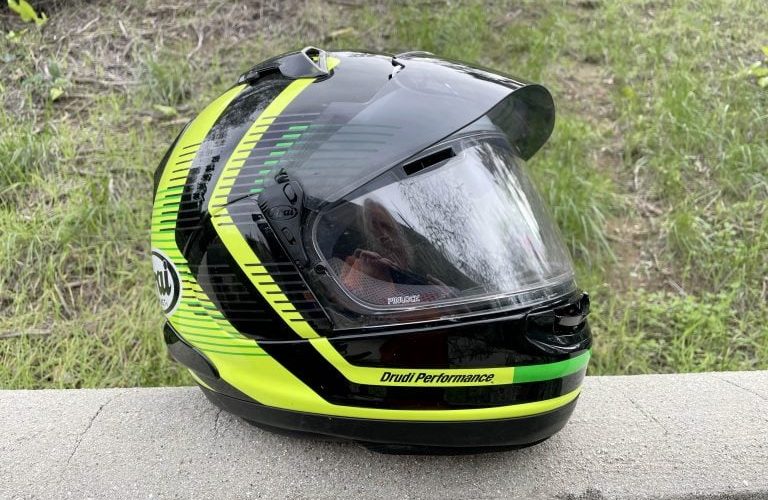





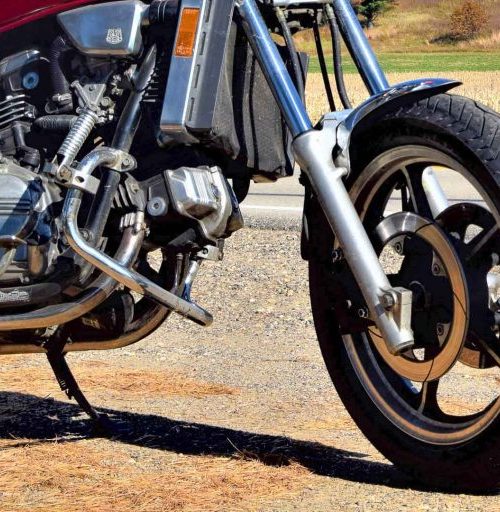
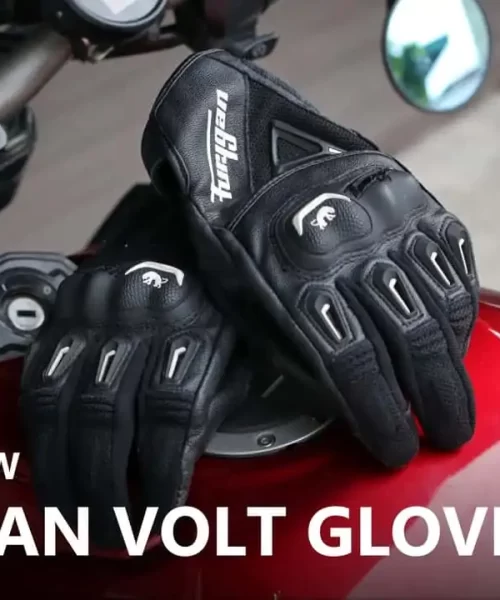
![Scorpion Covert Hoodie Review [Motorcycle Jacket Alternative]](https://motogeartalk.com/wp-content/uploads/2023/11/scorpion-covert-hoodie-review-technical-motorcycle-jacket-apparel-2-768x512-1-500x512.jpg)

